Abstract
The most important concept emerging from the management of complex hepatic trauma is that direct suture ligation of severed blood vessels and bile ducts is the most effective treatment. Three essential maneuvers are necessary: (1) the use of the finger fracture technique to expose the laceration widely, so that individual ligation of severed blood vessels and bile ducts can be accomplished under direct vision; (2) occluding the portal triad for 20 to 60 minutes; (3) closure of the hepatic incision over a viable omental pedicle. Two hundred consecutive patients with hepatic injuries were treated at the Trauma and Shock Unit of Bellevue Hospital between July 1976 and January 1982. One hundred and twenty-five injuries (63%) could be managed by superficial suture and drainage alone; 75 (37%) more extensive injuries required additional therapy; 47 of the 75 injuries required inflow occlusion for periods of up to 60 minutes, with the mean occlusion time of 30 minutes. All patients were pretreated with 30 to 40 mg/kg of Solu-Medrol prior to cross-clamping the portal triad. In addition, the liver was cooled to 27-32 degrees C topically by pouring 1 liter of iced Ringer's lactate directly on the liver surface, monitoring the temperature with an intra-hepatic probe. Ischemia time exceeded 20 minutes in 70%, 30 minutes in 40% and 60 minutes in 7% of patients. This approach, with complex hepatic trauma, has been dramatically effective. There were only four deaths (5.3%). One (1.3%) patient required reoperation for bleeding; three patients (4%) developed perihepatic abscesses; and two patients (3%) developed biliary fistulae that spontaneously closed. An extended right hepatectomy was necessary in the one patient who required reoperation for bleeding. This represents the only case of a formal hepatic resection in this series. Hepatic artery ligation was not employed in any case. These experiences strongly endorse the direct approach to the treatment of major hepatic lacerations by opening a lacerated liver sufficiently to ligate lacerated blood vessels and bile ducts, followed by closure over an omental pedicle. The wide-spread adoption of this technique will probably lower the mortality from massive liver injuries to 5-10%.
Full text
PDF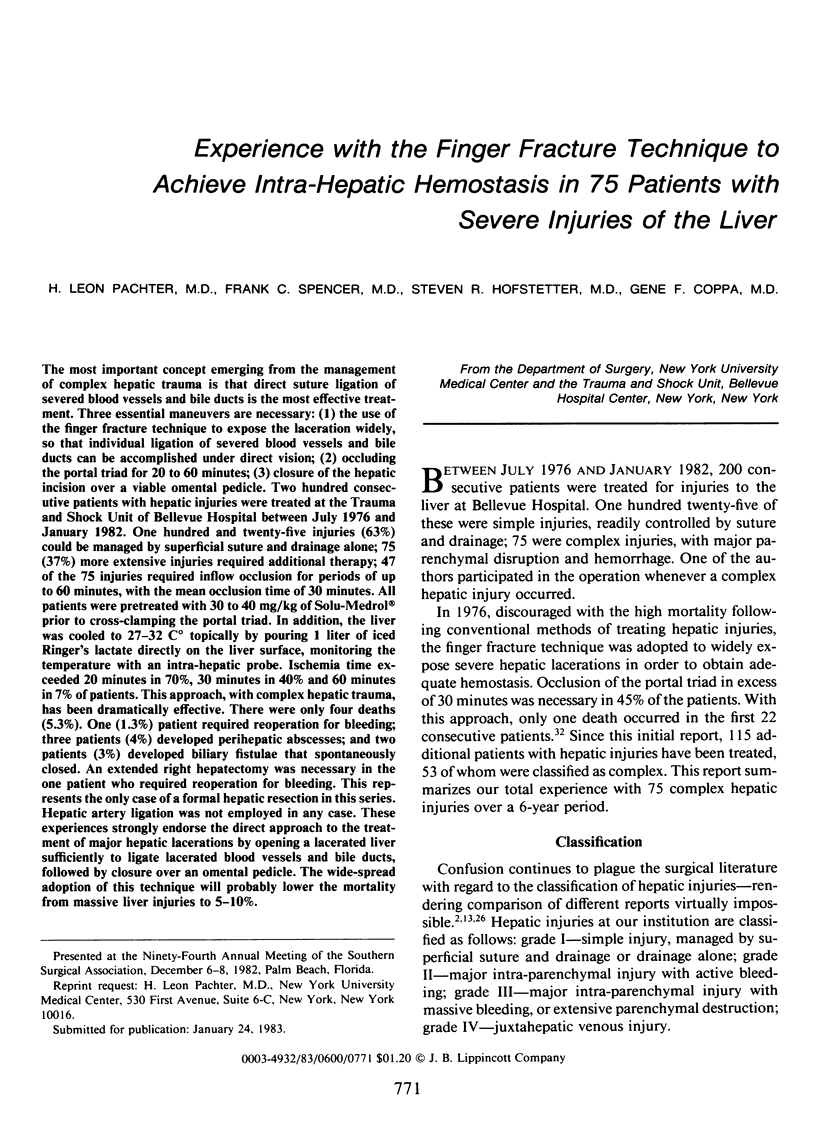
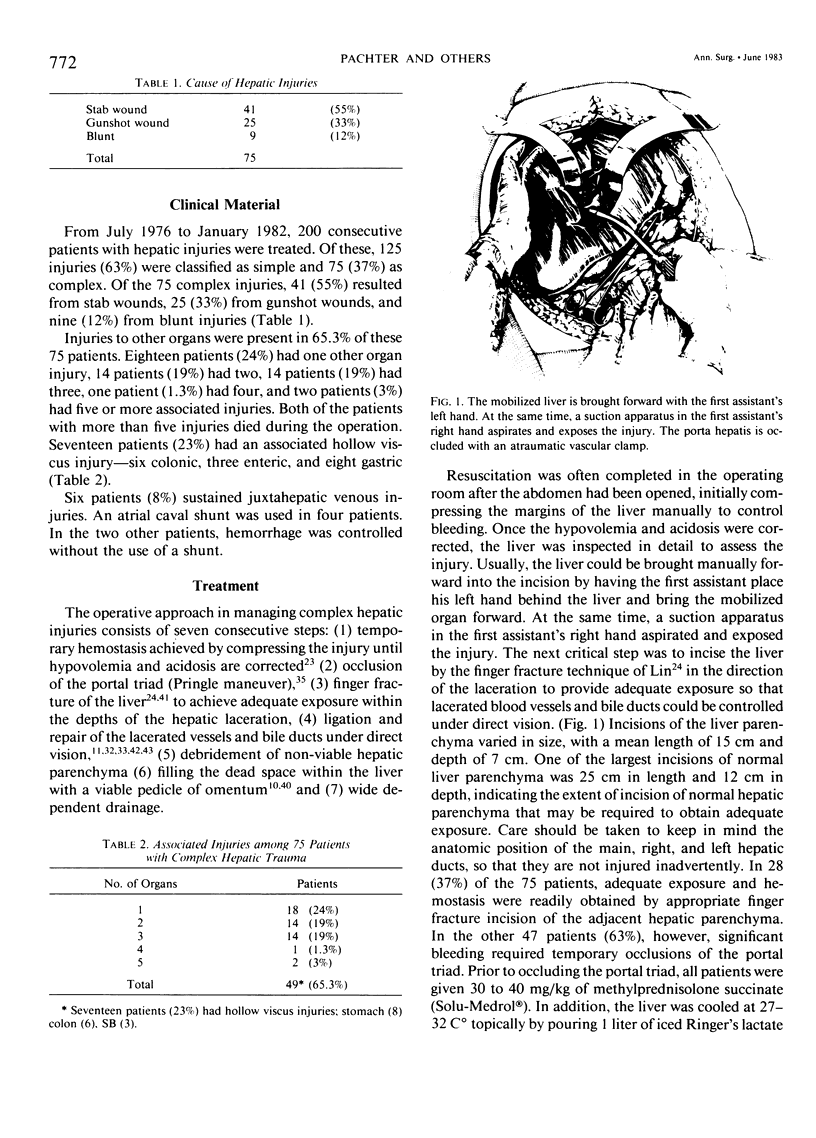
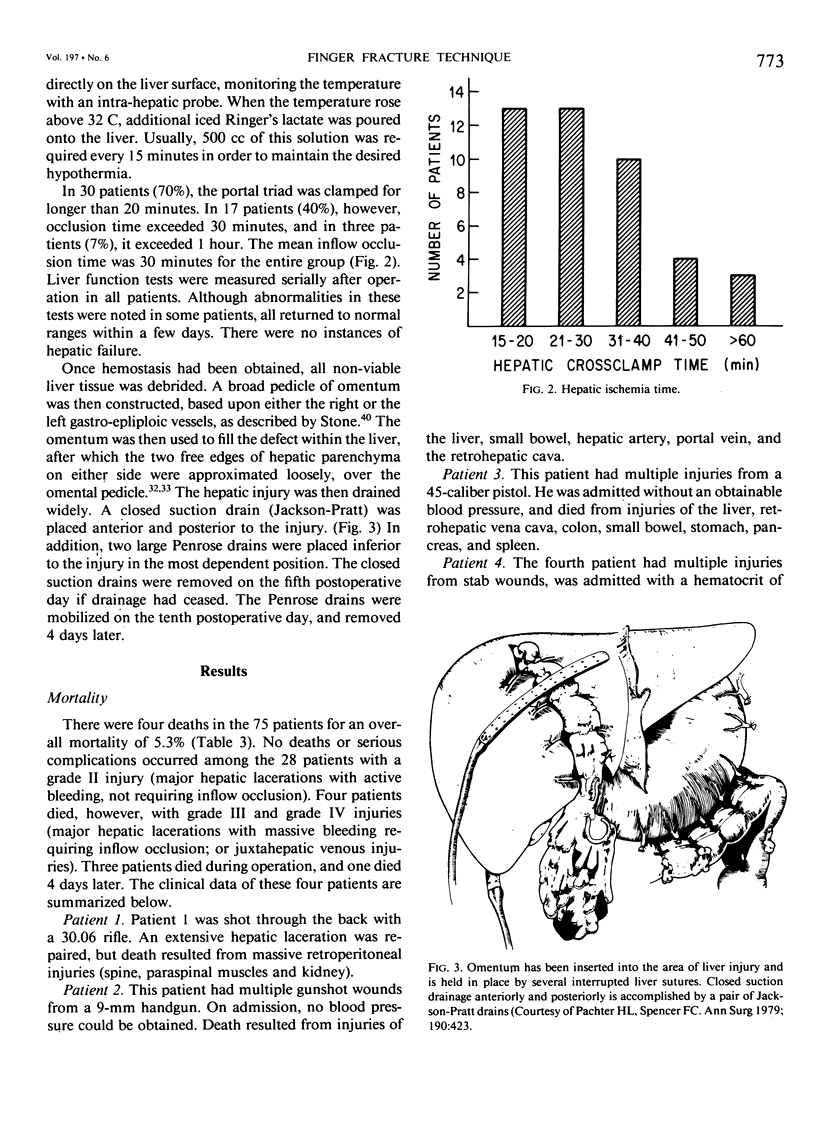
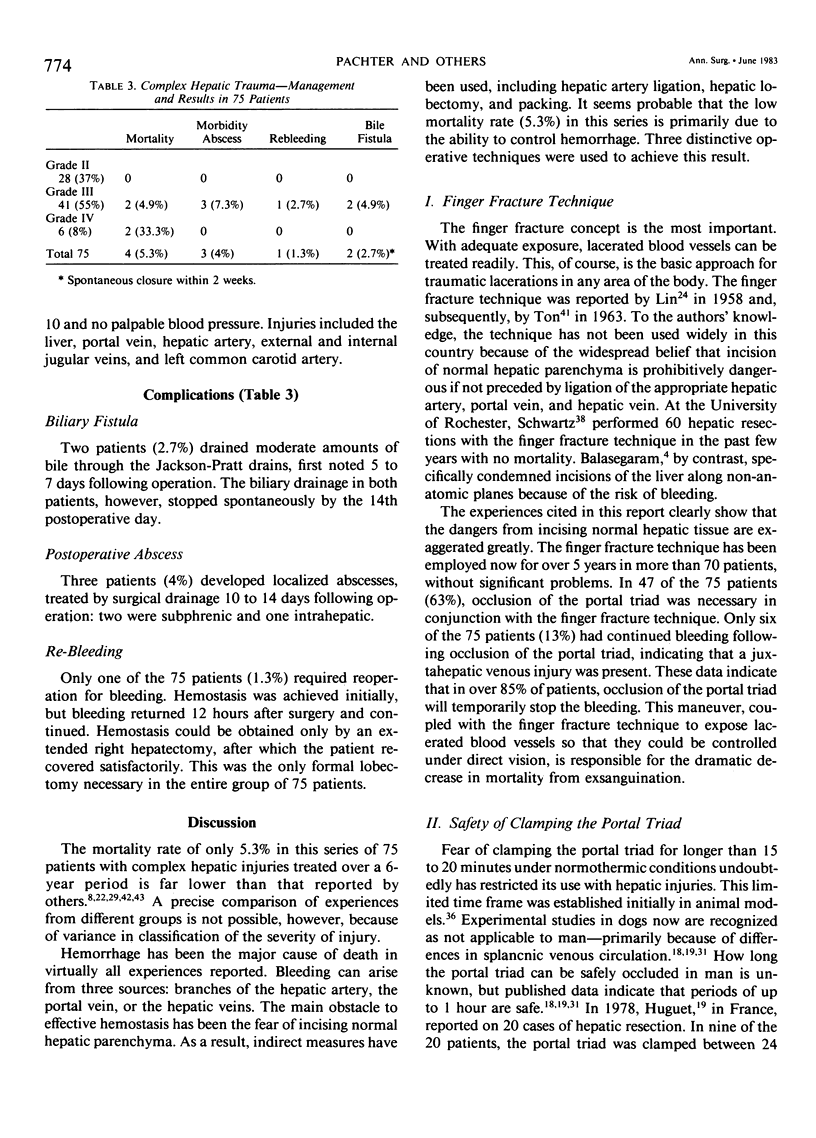

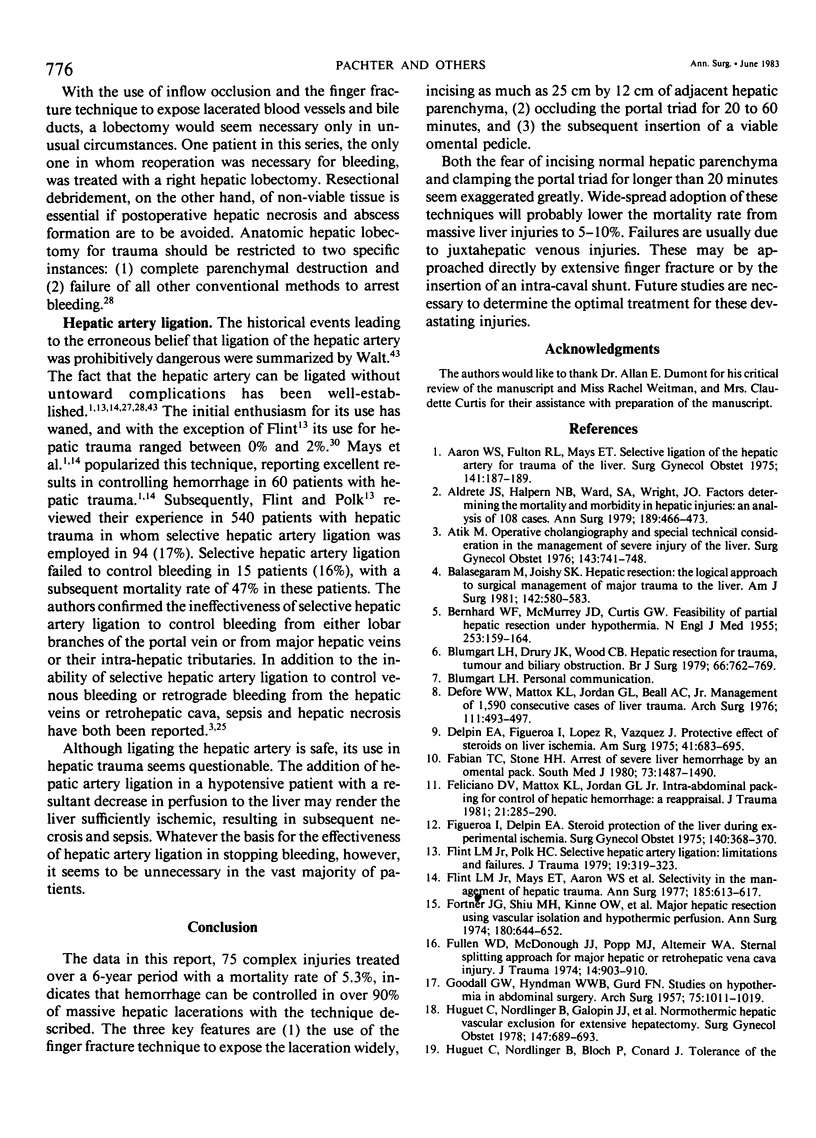
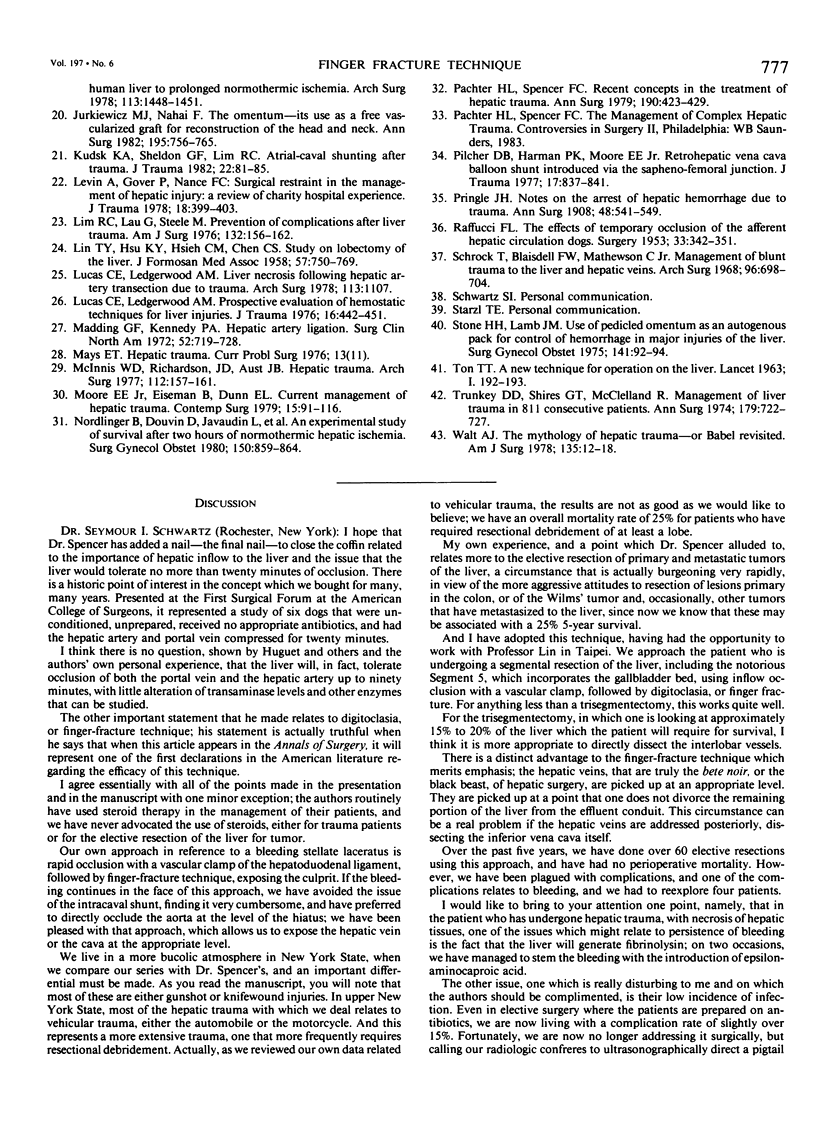
Selected References
These references are in PubMed. This may not be the complete list of references from this article.
- Aaron S., Fulton R. L., Mays E. T. Selective ligation of the hepatic artery for trauma of the liver. Surg Gynecol Obstet. 1975 Aug;141(2):187–189. [PubMed] [Google Scholar]
- Aldrete J. S., Halpern N. B., Ward S., Wright J. O. Factors determining the mortality and morbidity in hepatic injuries. Analysis of 108 cases. Ann Surg. 1979 Apr;189(4):466–474. [PMC free article] [PubMed] [Google Scholar]
- Atik M. Operative cholangiography and special technical consideration in the management of severe injury of the liver. Surg Gynecol Obstet. 1976 Nov;143(5):741–748. [PubMed] [Google Scholar]
- BERNHARD W. F., McMURREY J. D., CURTIS G. W. Feasibility of partial hepatic resection under hypothermia. N Engl J Med. 1955 Aug 4;253(5):159–164. doi: 10.1056/NEJM195508042530501. [DOI] [PubMed] [Google Scholar]
- Balasegaram M., Joishy S. K. Hepatic resection: the logical approach to surgical management of major trauma to the liver. Am J Surg. 1981 Nov;142(5):580–583. doi: 10.1016/0002-9610(81)90430-x. [DOI] [PubMed] [Google Scholar]
- Blumgart L. H., Drury J. K., Wood C. B. Hepatic resection for trauma, tumour and biliary obstruction. Br J Surg. 1979 Nov;66(11):762–769. doi: 10.1002/bjs.1800661103. [DOI] [PubMed] [Google Scholar]
- Defore W. W., Jr, Mattox K. L., Jordan G. L., Jr, Beall A. C., Jr Management of 1,590 consecutive cases of liver trauma. Arch Surg. 1976 Apr;111(4):493–497. doi: 10.1001/archsurg.1976.01360220189033. [DOI] [PubMed] [Google Scholar]
- Fabian T. C., Stone H. H. Arrest of severe liver hemorrhage by an omental pack. South Med J. 1980 Nov;73(11):1487–1490. doi: 10.1097/00007611-198011000-00021. [DOI] [PubMed] [Google Scholar]
- Feliciano D. V., Mattox K. L., Jordan G. L., Jr Intra-abdominal packing for control of hepatic hemorrhage: a reappraisal. J Trauma. 1981 Apr;21(4):285–290. doi: 10.1097/00005373-198104000-00005. [DOI] [PubMed] [Google Scholar]
- Figueroa I., Santiago-Delpín E. A. Steroid protection of the liver during experimental eschemia. Surg Gynecol Obstet. 1975 Mar;140(3):368–370. [PubMed] [Google Scholar]
- Flint L. M., Jr, Polk H. C., Jr Selective hepatic artery ligation: limitations and failures. J Trauma. 1979 May;19(5):319–323. doi: 10.1097/00005373-197905000-00003. [DOI] [PubMed] [Google Scholar]
- Flint L. M., Mays E. T., Aaron W. S., Fulton R. L., Polk H. C. Selectivity in the management of hepatic trauma. Ann Surg. 1977 Jun;185(6):613–618. doi: 10.1097/00000658-197706000-00001. [DOI] [PMC free article] [PubMed] [Google Scholar]
- Fortner J. G., Shiu M. H., Kinne D. W., Kim D. K., Castro E. B., Watson R. C., Howland W. S., Beattie E. J., Jr Major hepatic resection using vascular isolation and hypothermic perfusion. Ann Surg. 1974 Oct;180(4):644–652. doi: 10.1097/00000658-197410000-00030. [DOI] [PMC free article] [PubMed] [Google Scholar]
- Fullen W. D., McDonough J. J., Popp M. J., Altemeier W. A. Sternal splitting approach for major hepatic or retrohepatic vena cava injury. J Trauma. 1974 Nov;14(11):903–911. doi: 10.1097/00005373-197411000-00001. [DOI] [PubMed] [Google Scholar]
- GRAYDON R., GOODALL W., HYNDMAN W. W. B., GURD F. N. Studies on hypothermia in abdominal surgery. II. Occlusion of the vascular inflow to the liver. AMA Arch Surg. 1957 Dec;75(6):1011–1019. doi: 10.1001/archsurg.1957.01280180143022. [DOI] [PubMed] [Google Scholar]
- Huguet C., Nordlinger B., Bloch P., Conard J. Tolerance of the human liver to prolonged normothermic ischemia. A biological study of 20 patients submitted to extensive hepatectomy. Arch Surg. 1978 Dec;113(12):1448–1451. doi: 10.1001/archsurg.1978.01370240070012. [DOI] [PubMed] [Google Scholar]
- Huguet C., Nordlinger B., Galopin J. J., Bloch P., Gallot D. Normothermic hepatic vascular exclusion for extensive hepatectomy. Surg Gynecol Obstet. 1978 Nov;147(5):689–693. [PubMed] [Google Scholar]
- Jurkiewicz M. J., Nahai F. The omentum: its use as a free vascularized graft for reconstruction of the head and neck. Ann Surg. 1982 Jun;195(6):756–765. doi: 10.1097/00000658-198206000-00012. [DOI] [PMC free article] [PubMed] [Google Scholar]
- Kudsk K. A., Sheldon G. F., Lim R. C., Jr Atrial-caval shunting (ACS) after trauma. J Trauma. 1982 Feb;22(2):81–85. doi: 10.1097/00005373-198202000-00001. [DOI] [PubMed] [Google Scholar]
- Levin A., Gover P., Nance F. C. Surgical restraint in the management of hepatic injury: a review of Charity Hospital Experience. J Trauma. 1978 Jun;18(6):399–404. doi: 10.1097/00005373-197806000-00004. [DOI] [PubMed] [Google Scholar]
- Lim R. C., Jr, Lau G., Steele M. Prevention of complications after liver trauma. Am J Surg. 1976 Aug;132(2):156–162. doi: 10.1016/0002-9610(76)90041-6. [DOI] [PubMed] [Google Scholar]
- Lucas C. E., Ledgerwood A. M. Liver necrosis following hepatic artery transection due to trauma. Arch Surg. 1978 Sep;113(9):1107–1107. doi: 10.1001/archsurg.1978.01370210089014. [DOI] [PubMed] [Google Scholar]
- Lucas C. E., Ledgerwood A. M. Prospective evaluation of hemostatic techniques for liver injuries. J Trauma. 1976 Jun;16(6):442–451. doi: 10.1097/00005373-197606000-00003. [DOI] [PubMed] [Google Scholar]
- Madding G. F., Kennedy P. A. Hepatic artery ligation. Surg Clin North Am. 1972 Jun;52(3):719–728. doi: 10.1016/s0039-6109(16)39744-4. [DOI] [PubMed] [Google Scholar]
- McInnis W. D., Richardson J. D., Aust J. B. Hepatic trauma: pitfalls in management. Arch Surg. 1977 Feb;112(2):157–161. doi: 10.1001/archsurg.1977.01370020051005. [DOI] [PubMed] [Google Scholar]
- Nordlinger B., Douvin D., Javaudin L., Bloch P., Aranda A., Boschat M., Huguet C. An experimental study of survival after two hours of normothermic hepatic ischemia. Surg Gynecol Obstet. 1980 Jun;150(6):859–864. [PubMed] [Google Scholar]
- Pachter H. L., Spencer F. C. Recent concepts in the treatment of hepatic trauma: facts and fallacies. Ann Surg. 1979 Oct;190(4):423–429. doi: 10.1097/00000658-197910000-00001. [DOI] [PMC free article] [PubMed] [Google Scholar]
- Pilcher D. B., Harman P. K., Moore E. E., Jr Retrohepatic vena cava balloon shunt introduced via the sapheno-femoral junction. J Trauma. 1977 Nov;17(11):837–841. doi: 10.1097/00005373-197711000-00003. [DOI] [PubMed] [Google Scholar]
- Pringle J. H. V. Notes on the Arrest of Hepatic Hemorrhage Due to Trauma. Ann Surg. 1908 Oct;48(4):541–549. doi: 10.1097/00000658-190810000-00005. [DOI] [PMC free article] [PubMed] [Google Scholar]
- RAFFUCCI F. L. The effects of temporary occlusion of the afferent hepatic circulation in dogs. Surgery. 1953 Mar;33(3):342–351. [PubMed] [Google Scholar]
- Santiago Delpín E. A., Figueroa I., López R., Vázquez J. Protective effect of steroids on liver ischemia. Am Surg. 1975 Nov;41(11):683–685. [PubMed] [Google Scholar]
- Schrock T., Blaisdell F. W., Mathewson C., Jr Management of blunt trauma to the liver and hepatic veins. Arch Surg. 1968 May;96(5):698–704. doi: 10.1001/archsurg.1968.01330230006002. [DOI] [PubMed] [Google Scholar]
- Stone H. H., Lamb J. M. Use of pedicled omentum as an autogenous pack for control of hemorrhage in major injuries of the liver. Surg Gynecol Obstet. 1975 Jul;141(1):92–94. [PubMed] [Google Scholar]
- Trunkey D. D., Shires G. T., Mc Clelland R. Management of liver trauma in 811 consecutive patients. Ann Surg. 1974 May;179(5):722–728. doi: 10.1097/00000658-197405000-00026. [DOI] [PMC free article] [PubMed] [Google Scholar]
- Walt A. J. Founder's lecture: The mythology of hepatic trauma--or Babel revisited. Am J Surg. 1978 Jan;135(1):12–18. doi: 10.1016/0002-9610(78)90003-x. [DOI] [PubMed] [Google Scholar]


